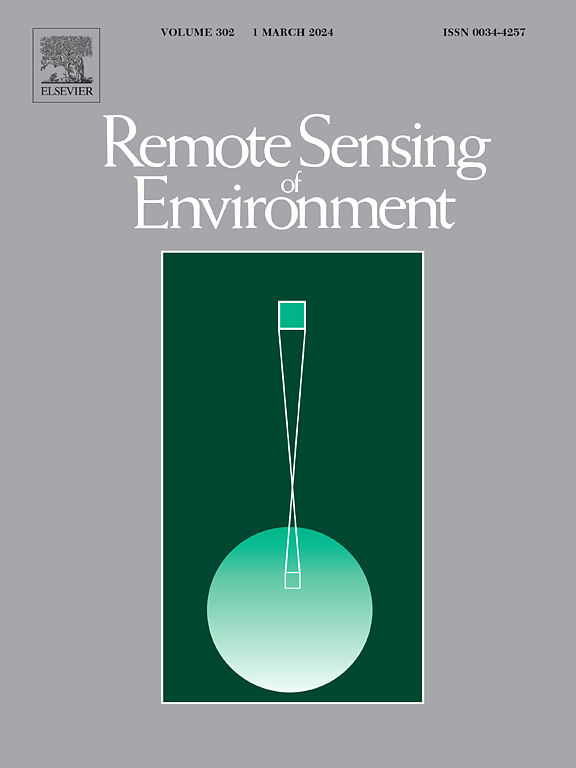Improvement of land surface phenology monitoring by fusing VIIRS observations with GOES-16/17 ABI time series
IF 11.1
1区 地球科学
Q1 ENVIRONMENTAL SCIENCES
引用次数: 0
Abstract
Land Surface Phenology (LSP) has been widely derived from polar-orbiting satellite observations to characterize terrestrial vegetation dynamics. However, the uncertainty of LSP detections over large areas is always a big concern because of cloud contamination in the satellite time series, particularly in persistently cloudy regions. The Advanced Baseline Imager (ABI) onboard Geostationary Operational Environmental Satellite-R (GOES-R) provides a high likelihood of obtaining cloud-free observations throughout the vegetation growing season due to the high temporal resolution of 10 minutes. Therefore, this study investigated LSP detections at 500 m pixels from VIIRS (Visible Infrared Imaging Radiometer), ABI, and fused VIIRS-ABI time series in 2019 over North America between 12°N and 48°N. Specifically, the 3-day composite VIIRS NBAR (Nadir Bidirectional Reflectance Distribution Function (BRDF)-Adjusted Reflectance) EVI2 (two-band Enhanced Vegetation Index) time series was first generated. Similarly, the 3-day composite ABI EVI2 time series was also produced after performing BRDF-adjustment of 10-min GOES-16/17 ABI surface reflectance. The 3-day VIIRS EVI2 time series was then fused with ABI EVI2 observations to generate the synthetic high spatiotemporal VIIRS-ABI EVI2 time series. Further, LSP was separately detected from the VIIRS, ABI, and fused VIIRS-ABI EVI2 time series. Finally, the three LSP detections were analyzed with the variation of cloud cover and ABI view zenith angle (VZA) and validated using the LSP reference produced from the fusion of Harmonized Landsat 8 and Sentinel-2 (HLS) observations with PhenoCam time series. The results showed that VIIRS-ABI LSP could overcome the limitations in the LSP detections from either VIIRS or ABI alone. The improvement of VIIRS-ABI LSP could be over 15 days relative to ABI LSP in large VZA regions and 5 days relative to VIIRS LSP in regions prone to persist cloud cover. Because of the high complementarity between the polar-orbiting and geostationary satellites, their fusion could significantly improve the generation of global LSP products.
利用GOES-16/17 ABI时间序列融合VIIRS观测改进地表物候监测
陆地表面物候学(Land Surface Phenology, LSP)广泛来源于极轨卫星观测,用于表征陆地植被动态。然而,由于卫星时间序列中的云污染,特别是在持续多云的地区,大面积LSP检测的不确定性一直是一个很大的问题。地球同步运行环境卫星- r (GOES-R)上的高级基线成像仪(ABI)由于10分钟的高时间分辨率,提供了在整个植被生长季节获得无云观测的高可能性。因此,本研究研究了2019年在北美12°N至48°N范围内,来自VIIRS(可见红外成像辐射计)、ABI和融合VIIRS-ABI时间序列的500 m像素LSP检测。具体而言,首先生成3天的复合VIIRS NBAR (Nadir Bidirectional Reflectance Distribution Function (BRDF)-Adjusted Reflectance) EVI2 (two-band Enhanced Vegetation Index)时间序列。同样,对10分钟GOES-16/17 ABI表面反射率进行brdf调整后,也得到3天ABI EVI2时间序列。然后将3天的VIIRS EVI2时间序列与ABI EVI2观测数据融合,生成合成的高时空VIIRS-ABI EVI2时间序列。此外,从VIIRS、ABI和融合VIIRS-ABI EVI2时间序列中分别检测LSP。最后,结合云量和ABI视图天顶角(VZA)的变化对三种LSP检测方法进行了分析,并使用Harmonized Landsat 8和Sentinel-2 (HLS)观测数据与PhenoCam时间序列融合产生的LSP参考数据进行了验证。结果表明,VIIRS-ABI LSP可以克服单独使用VIIRS或ABI检测LSP的局限性。在VZA较大的地区,VIIRS-ABI LSP相对ABI LSP的改善可达15天以上,在持续云量较大的地区,VIIRS-ABI LSP相对ABI LSP的改善可达5天以上。由于极轨卫星和地球静止卫星之间的高度互补性,它们的融合可以显著提高全球LSP产品的生成速度。
本文章由计算机程序翻译,如有差异,请以英文原文为准。
求助全文
约1分钟内获得全文
求助全文
来源期刊

Remote Sensing of Environment
环境科学-成像科学与照相技术
CiteScore
25.10
自引率
8.90%
发文量
455
审稿时长
53 days
期刊介绍:
Remote Sensing of Environment (RSE) serves the Earth observation community by disseminating results on the theory, science, applications, and technology that contribute to advancing the field of remote sensing. With a thoroughly interdisciplinary approach, RSE encompasses terrestrial, oceanic, and atmospheric sensing.
The journal emphasizes biophysical and quantitative approaches to remote sensing at local to global scales, covering a diverse range of applications and techniques.
RSE serves as a vital platform for the exchange of knowledge and advancements in the dynamic field of remote sensing.
 求助内容:
求助内容: 应助结果提醒方式:
应助结果提醒方式:


